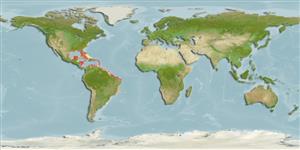Bivalvia |
Cardiida |
Donacidae
Environment: milieu / climate zone / djupintervall / distribution range
Ekologi
; djupintervall 6 - 20 m (Ref. 104365). Tropical
Western Atlantic: USA to Brazil.
Length at first maturity / Size / Weight / Age
Könsmognad: Lm ? range ? - ? cmCommon length : 6.5 cm TL hane/ej könsbestämd; (Ref. 344)
Shell wedge-shaped, heavy, moderately inflated, with rhomboidal outline. Shell surface smooth. Posterodorsal slope somewhat flat. Pallial sinus large. Hinge with 2 lateral teeth (1 bifid) on each valve, lateral teeth absent. Umbones slightly posterior. Periostracum thin, glossy. Colour: tan cream with purple umbonal region; periostracum brown (Ref. 344).
It has a total length of 6.5 cm (Ref. 344). Combination depth range: min from literature, max from estimate. It is found infaunal in shallow sandy bottoms (Ref. 344). Infaunal (Ref. 104365).
Life cycle and mating behavior
Könsmognad | Reproduktion | Lek | Eggs | Fecundity | Larvae
Members of the class Bivalvia are mostly gonochoric, some are protandric hermaphrodites. Life cycle: Embryos develop into free-swimming trocophore larvae, succeeded by the bivalve veliger, resembling a miniature clam.
Leal, J.H. 2003 Bivalves. p. 25-98. In Carpenter, K.E. (ed.). The living marine resources of the Western Central Atlantic. Volume 1: Introduction, molluscs, crustaceans, hagfishes, sharks, batoid fishes, and chimaeras. FAO Species Identification Guide for Fishery Purposes and American Society of Ichthyologists and Herpetologists Special Publication No. 5. 1600p. (Ref. 344)
IUCN Red List Status
(Ref. 130435: Version 2025-1)
CITES status (Ref. 108899)
Not Evaluated
Not Evaluated
Threat to humans
Human uses
Fiskeri: kommersiell
| FishSource |
Verktyg
Ytterligare information
Trophic EcologyFood items (preys)
Födosammansättning
Födointag
Predatorer
Population dynamicsTillväxt
Max. ages / sizes
Length-weight rel.
Length-length rel.
Length-frequencies
Mass conversion
Abundans
PhysiologySyreförbrukning
Human RelatedStamps, coins, misc.
Internet-källor
Estimates based on models
Price category
Unknown.
